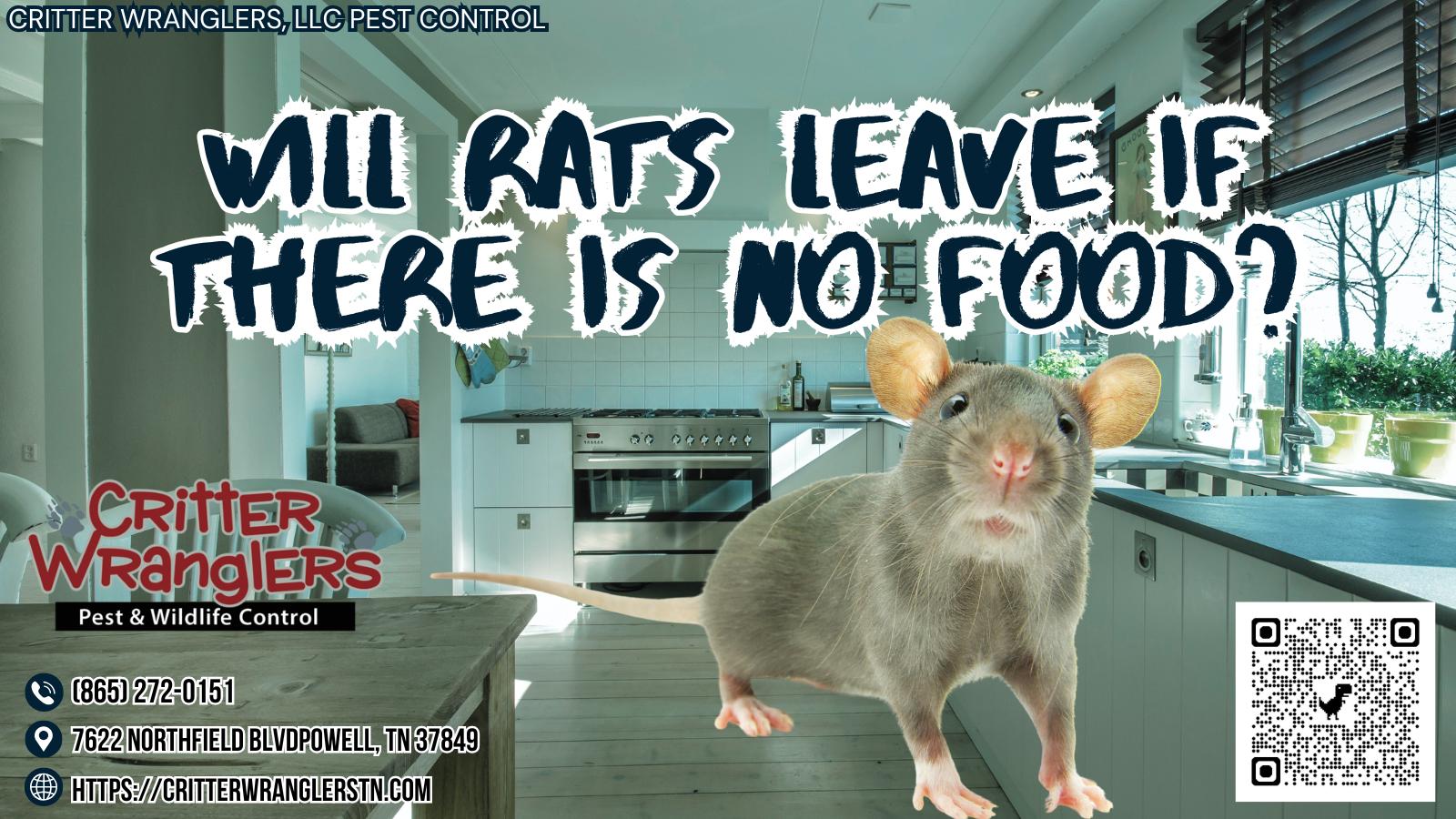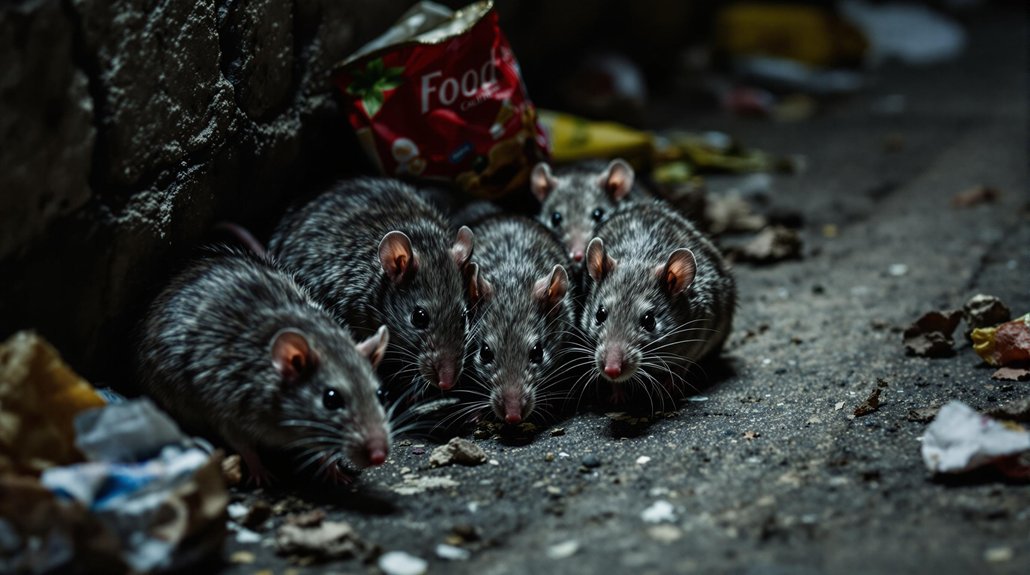Critter Wranglers, LLC Blog
Have an issue? Contact us today

Will Rats Leave if There Is No Food?
Rats depend heavily on food sources for survival. If food becomes scarce, they may leave an area in search of sustenance. This movement typically occurs when food has been absent for an extended period. Though they can adapt to different environments, a lack of food can prompt them to seek new habitats that offer better resources. Keeping areas clean and eliminating food sources can help reduce rat populations. Understanding rat behavior and environmental influences is key to managing infestations effectively. There are many more insights available on how to prevent and control their presence in your space.
Key Article Highlights
- Rats are opportunistic feeders and will search for food sources if their current supply is depleted.
- Lack of food can prompt rats to migrate to areas with better resources.
- Eliminating food sources is a critical step in reducing rat populations effectively.
- Rats may leave an area if they cannot find sufficient sustenance, but they might also adapt by scavenging.
- Proactive sanitation efforts can significantly deter rats and encourage them to seek food elsewhere.
Understanding Rat Behavior

Rats exhibit a range of behaviors that are fundamental for their survival. One important aspect of their behavior is their social structures. Rats are social animals, often living in groups. These groups help them communicate and cooperate with each other. Within these groups, there is often a hierarchy that determines leadership and roles.
Another key behavior is territorial behavior. Rats are known to defend their living areas from other rats. This defense helps them protect their resources and guarantee safety. Understanding these behaviors is essential for those who wish to serve and support rat populations. By recognizing their social needs and territorial instincts, we can create environments that promote their well-being and minimize conflict. This knowledge is significant for effective management and care.
Food Sources for Rats
While exploring their habitats, one can find that rats are opportunistic feeders, consuming a wide variety of food sources. Their rat diets often include grains, fruits, vegetables, and even human food scraps. These creatures have strong food preferences, which can vary based on availability. For example, they are attracted to high-calorie foods, such as nuts and seeds. In urban areas, rats may scavenge from garbage or seek out pet food left outdoors. In rural settings, they may find crops or livestock feed. Understanding these food sources is essential for effective management and control methods. By recognizing what rats eat, we can take steps to reduce their access to food and help mitigate infestations.
Survival Strategies of Rats

Rats have developed various survival strategies to thrive in different environments. They are skilled at identifying food sources and exhibit unique nesting behaviors. Their ability to adapt and show resilience allows them to survive in challenging conditions.
Food Sources Identification
Survival in the wild hinges on the ability to identify reliable food sources. Rats exhibit remarkable adaptability in finding food types that suit their habitat preferences. They thrive in various environments, from urban areas to rural fields. Understanding what they consume can help us manage their presence.
- Grains and seeds: Common staples that attract rats.
- Fruits and vegetables: Fresh produce often becomes a feast.
- Leftover scraps: Human food waste is a major food source.
Nesting Behavior Insights
Understanding nesting behavior is essential for grasping how these creatures thrive in diverse environments. Rats actively seek suitable shelter to create their nests. They prefer places that offer safety and warmth, such as burrows, attics, or basements. The choice of nesting materials is vital. Rats often use soft items like shredded paper, fabric, or dried grass to build their homes. These materials provide insulation and comfort, allowing them to raise their young effectively. By choosing specific areas and materials, rats can protect themselves from predators and harsh conditions. Their nesting behavior reflects their survival strategies, showing how they adapt to their surroundings. Understanding these patterns can help us manage their populations and reduce human-rat conflicts.
Adaptation and Resilience
Although they face numerous challenges in their environments, rats demonstrate remarkable adaptation and resilience. Their ability to thrive in urban settings showcases their behavioral adaptation. Rats can change their habits and diets to survive when food is scarce. This urban resilience allows them to find new sources of nourishment, often in unexpected places.
- They scavenge through trash, proving their resourcefulness.
- They learn quickly from their surroundings, adapting to dangers.
- Their social structures help them survive as a group.
These strategies highlight the rats' determination to continue living despite hardships. Understanding their survival methods can inspire us to support vulnerable communities facing similar challenges. By fostering resilience, we can help all creatures, including ourselves, adapt better to our environments.
Factors Influencing Rat Movement
Numerous factors influence the movement of rats in their environment. One key factor is food availability, which affects rat migration patterns. When food is scarce, rats may travel further in search of sustenance. Environmental triggers also play a significant role in their movement. Changes in weather, temperature, and habitat can prompt rats to relocate. For example, heavy rain or flooding may drive them to find higher ground. Additionally, the presence of predators or human activity can encourage rats to move to safer areas. Understanding these factors is essential for effective pest control and community health efforts. By addressing the conditions that affect rat mobility, we can better manage their populations and reduce potential risks.
Duration of Food Scarcity

The duration of food scarcity considerably impacts rat behavior and population dynamics. When food becomes limited for extended periods, rats are forced to adapt. They may become more aggressive in their search for food, leading to increased competition among them. This behavior can cause stress in their social structures and may even result in a decline in their population.
- Rats may invade homes in desperation.
- Increased competition can lead to violence among them.
- Food scarcity can push them into unfamiliar areas.
Understanding the effects of food scarcity helps us manage environments better. By ensuring proper waste disposal and food storage, we can reduce the chances of attracting these adaptable creatures. Compassionate efforts can lead to healthier living spaces for all.
Signs of Rat Infestation
Recognizing the signs of rat infestation is essential for effective management. Common indicators include droppings and urine, which can often be found in areas where rats travel. Additionally, gnaw marks and damage to food packages or structures signal the presence of these pests.
Droppings and Urine
Although small in size, rat droppings and urine are significant indicators of an infestation. These waste products can pose health risks and signal the presence of rats in your space. Early detection is essential for effective management.
- Health hazards for your family
- Unpleasant odors in your home
- Increased anxiety over cleanliness
To address this issue, focus on droppings removal and urine detection. Regular inspections can help identify signs of rats. If you find droppings or smell urine, take action immediately. Cleaning and sanitizing the affected areas can reduce health risks. If needed, consult professionals for thorough removal and prevention strategies. Your proactive efforts can create a safer and healthier environment for everyone.
Gnaw Marks and Damage
Gnaw marks are clear signs of a rat infestation and can often be found on walls, furniture, and food packaging. These marks indicate that rats are present and actively gnawing on materials. Conducting a damage assessment is vital to understand the extent of the issue.
| Type of Damage | Location |
|---|---|
| Gnaw Marks | Walls and Baseboards |
| Damaged Food Packaging | Pantry and Cabinets |
| Chewed Electrical Wires | Attics and Basements |
Identifying these signs can help in taking appropriate action. It is important to address a rat infestation quickly to prevent further damage and guarantee a safe environment for everyone.
Preventing Rat Infestations

A proactive approach is vital for preventing rat infestations in homes and businesses. Implementing effective preventive measures can create a safer environment for everyone.
- Protect your loved ones from health risks.
- Safeguard your property from costly damages.
- Promote a clean and welcoming space for all.
Adopting proper sanitation practices is essential. Keep food stored securely in sealed containers and promptly clean up spills and crumbs. Regularly dispose of garbage and maintain a tidy space to eliminate potential food sources. Additionally, seal any gaps or holes in walls and foundations to block entry points. By focusing on these simple steps, communities can work together to prevent rat infestations and guarantee a healthier living environment for everyone.
Impact of Environmental Conditions
Environmental conditions play a crucial role in influencing rat populations and their behavior. Habitat changes, such as urban development or deforestation, can greatly affect where rats live. When their environment changes, rats may seek new areas for shelter and food. Weather effects also impact rat behavior. For instance, during harsh winters, rats may move indoors in search of warmth and food. Conversely, heavy rain can flood their burrows, forcing them to relocate. Understanding these environmental factors is essential for those who want to manage rat populations. By recognizing how habitat changes and weather effects influence rats, we can better prepare to address potential infestations and create safer spaces for our communities.
Seeking Professional Help

Many homeowners face the challenge of managing rat infestations. When these pests invade, it can feel overwhelming. Seeking professional help is often the best solution. Professional extermination services provide effective pest control, ensuring that rats are removed safely and thoroughly.
- The fear of health risks from rats can weigh heavily on families.
- The stress of dealing with a rodent problem can disrupt daily life.
- Knowing you have support can bring peace of mind.
Frequently Asked Questions
How Quickly Do Rats Reproduce in the Absence of Food?
Rats typically have high reproduction rates, even in challenging conditions. Their survival strategies enable them to breed quickly, often producing litters every three weeks. Limited food may slow growth, but they can still reproduce effectively.
Can Rats Eat Non-Food Items to Survive?
Rats exhibit remarkable adaptability in non-food survival situations. They may consume non-food items, such as paper or fabric, to obtain necessary nutrients. Understanding rat behavior can aid in developing effective management strategies for infestations.
What Diseases Do Rats Carry if They Leave?
In a world reminiscent of medieval times, the threat of rat-borne diseases remains significant. Rodent health issues can lead to illnesses such as leptospirosis and hantavirus, posing risks to humans and communities alike. Awareness is essential.
Do Rats Prefer Urban or Rural Environments When Searching for Food?
Rats generally prefer urban habitats over rural landscapes when searching for food. Urban areas provide abundant food sources and shelter, making them more appealing. However, they can adapt to rural environments if necessary.
Can Rats Smell Food From Long Distances?
Rats possess remarkable rat scent detection abilities, allowing them to sense food from considerable distances. Factors such as odor intensity, food type, and environmental conditions greatly influence their attraction, enhancing their foraging efficiency in diverse settings.
